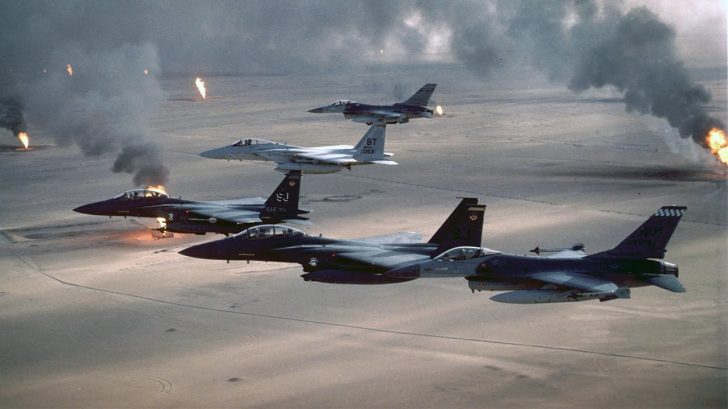The Air Battle of Samurra was Iraq’s last offensive before grounding their aircraft during the Gulf War. It featured a showdown between the most iconic Cold War-era jet fighters – the MiG-25 Foxbat and the F-15 Eagle.
Evacuation
The most notable engagement between these two fighters occurred in 1991 during Operation Desert Storm. By January 19th of that year, it became clear that Iraqi aircraft could not openly engage with the Coalition Air Forces. As a response, Iraqi leaders stored their fighters inside guarded bunkers for a future battle.
The Coalition was already ahead of them at that point, as they targeted aircraft hangars to destroy the Iraqi Air Force’s arsenal. In just ten days, over 117 Iraqi airplanes were destroyed by Coalition forces.
As a response, Iraq evacuated its remaining aircraft to Iran. To counter this, the USAF established a “wall” of F-15s along the border with one mission – shoot down any aircraft attempting to flee Iraq.
Rivals
On January 17, a unit of Eagles engaged two MiG-25s by firing ten missiles at the Foxbats. However, the Soviet jets’ unmatchable speed was enough for it to flee the encounter.
Two days later, another set of Eagles engaged Foxbats at a closer range and successfully neutralized two of them.
After losing almost 60% of their Foxbats, the remaining models were sent to participate in the Iraqi Air Force’s last effort to engage the F-15 Eagles.
Operation Samurra
The plan involved coordinating two flights of Foxbats from different directions onto an isolated group of F-15s at the border. If the F-15s were to respond to one of the attacks, the other group would fly into a flank position to overwhelm the Eagles.
Iraq was given a chance on January 30th after an Iraqi intelligence tower unit intercepted usable Coalition communications. Two patrolling F-15s approached its minimum fuel required for a comfortable flight, meaning it needed an hour-and-a-half round trip to the nearest aerial tanker. This meant that only two F-15 Eagles were left in the area.
Showdown
Iraqi officials quickly deployed two MiG-25s – one taking off from Qadessiya, the other from Tammuz.
Lt. Robert Hehemann fired two missiles after seeing a MiG, but one failed to detonate. Subsequently, the MiG-25 managed to get a lock on Hehemann and fired an R-40 missile. It damaged Hehemann’s left engine but nothing more.
Meanwhile, Captain Thomas Dietz engaged the other MiG-25 and attempted to fire several missiles. After three failed attempts, the MiG-25 got a lock on the Eagle, but Dietz had already headed east to disengage.
Now unoccupied, the MiG-25 fired missiles at Hehemann as he continued to dogfight with the other Foxbat. Fortunately, Hehemann avoided the missiles by using his chaff and flares.
The two MiG-25s finally disengaged to the west in full afterburner, towards Tammuz Air Base.
Credited Kill?
The Iraqi Air Force quickly credited one of the Foxbat pilots with a possible victory. This was later upgraded to a confirmed victory after a smuggler discovered an F-15 wreck near the area where Iraqi radars lost track of an Eagle. However, there were no records of an F-15 being shot down in the West Baghdad area on January 30.
By February, all IrAF activity had ceased as the Coalition asserted dominance in the sky.



